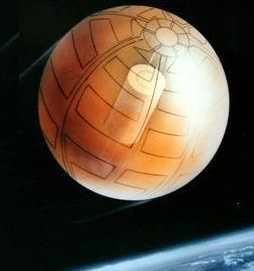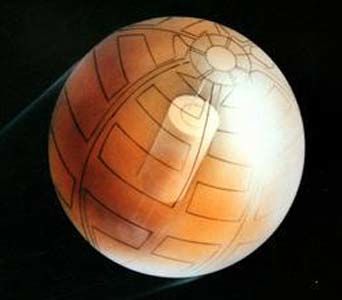
Home - Search - Browse - Alphabetic Index: 0- 1- 2- 3- 4- 5- 6- 7- 8- 9
A- B- C- D- E- F- G- H- I- J- K- L- M- N- O- P- Q- R- S- T- U- V- W- X- Y- Z
ITV
 ITV |
Status: Operational 1985. First Launch: 1985-12-13. Last Launch: 1985-12-13. Number: 4 . Gross mass: 82 kg (180 lb).
The Instrumented Target Vehicle was a relatively sophisticated active satellite. Battery powered, the balloon satellite remained inert and uninflated in orbital storage until the inflation command was transmitted to it. This would only come minutes before the intercept test, and was given as the satellite passed over a Hawaiian ground station. This would set the target up for an intercept over the California coast by an ASAT launched by an F-15A from Edwards AFB.
The ITV was inflated by a hydrazine monopropellant / ruthenium catalyst gas generator. This was calculated to inflate, heat and maintain the Kevlar balloon at the desired infrared signature required for the ASAT homing vehicle's sensor.
Data from a variety of sensors on the external surface of the balloon were telemetered back to ground stations. The few frames of data that would be received between inflation and intercept allowed the balloon's infrared signature and the geometry of the impact by the interceptor to be determined.
Temperature sensors were embedded in the Kevlar surface at various points. Magnetometers allowed determination of the attitude of the ITV. A grid of break-wires on the surface allowed the location of any impact to be determined.
An omni directional low-power continuous wave radar Miss Distance Indicator sent back data in case the hit-to-kill interceptor did not impact the target. This allowed misses out to around 30 m to be determined; misses beyond that range could be analyzed by post-test radar data.
More at: ITV.
Family: anti-satellite target. Country: USA. Launch Vehicles: Scout, Scout G-1. Launch Sites: Wallops Island, Wallops Island LA3A. Agency: USAF, Avco. Bibliography: 110, 2, 279, 6, 11246, 12699.
 | USA 13 Credit: Manufacturer Image |
1985 December 13 - . 02:35 GMT - . Launch Site: Wallops Island. Launch Complex: Wallops Island LA3A. LV Family: Scout. Launch Vehicle: Scout G-1.
- USA 13 - . Payload: ITV 1 ASAT Balloon Target. Nation: USA. Agency: USAF. Class: Military. Type: Anti-satellite system target. Spacecraft: ITV. Decay Date: 1989-05-11 . USAF Sat Cat: 16328 . COSPAR: 1985-114A. Apogee: 691 km (429 mi). Perigee: 311 km (193 mi). Inclination: 37.10 deg. Period: 94.60 min. Target balloon for F-15-launched ASAT missile. The battery-powered vehicle remained uninflated in orbit until a test was planned. Orbital decay data indicated the balloon was never inflated. It decayed without an intercept being attempted..
- USA 14 - .
Payload: ITV 2 ASAT Balloon Target. Nation: USA.
Agency: USAF.
Class: Military.
Type: Anti-satellite system target. Spacecraft: ITV.
Decay Date: 1987-08-09 . USAF Sat Cat: 16329 . COSPAR: 1985-114B. Apogee: 450 km (270 mi). Perigee: 284 km (176 mi). Inclination: 37.10 deg. Period: 91.90 min.
Target balloon for F-15-launched ASAT missile. The battery-powered vehicle remained uninflated in orbit until a test was planned. Orbital decay data indicates the balloon was inflated on 18 December 1986. However for operational or political reasons no intercept was ever attempted.
- ITV 1 Balloon - . Payload: ITV 1 Balloon. Nation: USA. Agency: USAF. Class: Military. Type: Anti-satellite system target. Spacecraft: ITV. Decay Date: 1987-03-02 . USAF Sat Cat: 17247 . COSPAR: 1985-114D. Apogee: 737 km (457 mi). Perigee: 310 km (190 mi). Inclination: 37.00 deg. Period: 95.10 min.
- ITV 1 Balloon - . Nation: USA. Agency: NASA. Class: Military. Type: Anti-satellite system target. Spacecraft: ITV. Decay Date: 1989-05-11 . USAF Sat Cat: 16328 . COSPAR: 1985-114xx. Apogee: 160 km (90 mi). Perigee: 148 km (91 mi). Inclination: 37.00 deg. Period: 87.60 min.
Back to top of page
Home - Search - Browse - Alphabetic Index: 0- 1- 2- 3- 4- 5- 6- 7- 8- 9
A- B- C- D- E- F- G- H- I- J- K- L- M- N- O- P- Q- R- S- T- U- V- W- X- Y- Z
© 1997-2019 Mark Wade - Contact
© / Conditions for Use